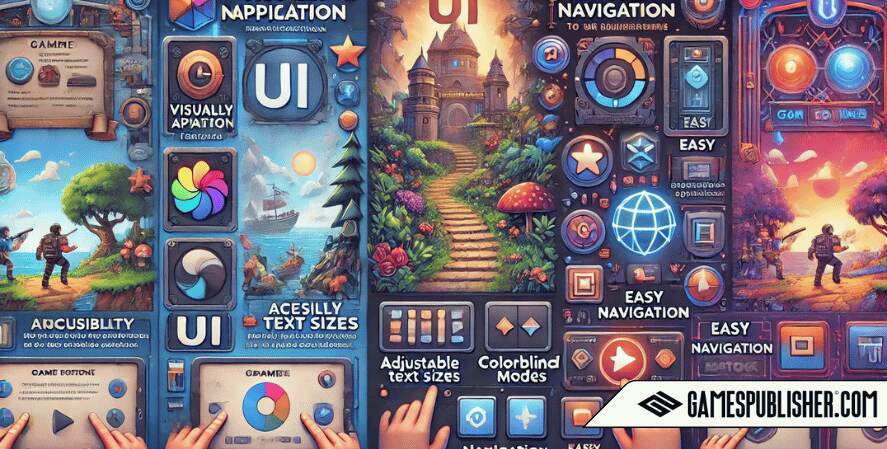At Gamespublisher.com, we know UX and UI design are vital to game development and publishing.
Great UX/UI design can have a significant impact on a game’s success. It enhances player satisfaction and drives engagement.
This article explores how UX and UI design can shape player experience. They can also contribute to a game’s success.
Understanding UX and UI

Definition of UX
User Experience (UX) refers to the overall feel of the game and how players interact with it. It means creating a seamless and enjoyable experience. Each interaction should feel natural and rewarding.
Definition of UI
UI is about the game’s layout. It includes buttons, icons, screens, and menus.
UI design aims to present these elements in a way that is both beautiful and functional. It makes navigation easy.
Difference Between UX and UI
UX focuses on the whole experience and the player’s emotions. UI focuses on the visuals and interaction. Together, they create a cohesive and engaging game experience.
The Role of UX in Game Development

Player Engagement
A well-designed UX is crucial for keeping players engaged. The game has intuitive controls. It also has clear objectives. Rewarding feedback keeps players immersed.
Player Retention
Good UX design helps retain players by providing satisfying interactions and reducing frustration. Continuous refinement based on user feedback can maintain player interest and loyalty.
Emotional Impact
Good UX design can evoke emotions. It enhances the storytelling of a game and creates memorable experiences for players.
The Role of UI in Game Development
Visual Appeal
UI design makes a game visually appealing and easy to navigate. A well-crafted UI draws players in and ensures they can easily find and use the game’s features.
Accessibility
Well-designed UIs can make games easier for more people to play. This includes those with disabilities.
These features include adjustable text sizes, colorblind modes, and easy navigation. They make games inclusive and fun for everyone.
Feedback and Responsiveness
UI elements provide feedback to player actions. This makes for a more responsive and interactive gaming experience.
Visual cues, sound effects, and haptic feedback help players understand. They show the results of their actions.
Best Practices in UX/UI Design for Games

Consistency
Consistency in design helps players learn the game. It also helps them master it faster. Consistent visual cues, controls, and feedback mechanisms reduce frustration and enhance enjoyment.
User-Centered Design
Designing with the player in mind is essential. User testing and feedback let developers find pain points. They can then make needed adjustments. This ensures the game meets its audience’s needs and expectations.
Simplicity and Clarity
Clear and simple UI elements prevent players from feeling overwhelmed. Complex interfaces can lead to confusion. To avoid this, focus on simplicity and clarity. They make interactions intuitive and enjoyable.
Iteration and Testing
Continuous testing and iteration are key to refining UX/UI design. Testing with real users happens often. Small improvements keep the game engaging and fun. They do so through its whole life.
Case Studies and Examples
Successful Games with Great UX/UI
- The Legend of Zelda: Breath of the Wild: The game is known for its easy controls and immersive world. It exemplifies great UX design. The UI is minimalistic but informative. It lets players focus on exploration and discovery.
- Fortnite: Epic Games’ Fortnite offers a smooth UX. It has easy menus and quick controls. The game’s UI design has vibrant colors and clear icons. It makes the game easy and fun for a wide audience.
Lessons Learned from UX/UI Failures
- Anthem: The game had a promising premise. But, Anthem had UX/UI issues. These led to player frustration. Complex menus and unclear objectives were major pain points. They showed the need for simplicity and clarity in design.
- Mass Effect: Andromeda: Critics criticized the game. They said its UX/UI design was inconsistent. They focused on character animations and the interface. These issues hurt the experience. They show the need for thorough testing and iteration.
Future Trends in UX/UI Design for Games

Immersive Experiences
Advances in technology, like Virtual Reality (VR) and Augmented Reality (AR), greatly affect UX/UI design.
These technologies offer new chances to make immersive experiences. They engage players in novel ways.
AI and Personalization
Artificial Intelligence (AI) is playing an increasingly important role in creating personalized gaming experiences.
By analyzing player behavior and preferences, AI can tailor the game experience to individual users, enhancing engagement and satisfaction.
Cross-Platform Design
With the rise of gaming on multiple platforms and devices, designing for cross-platform compatibility is becoming crucial.
Ensuring that the UX/UI remains consistent and intuitive across different devices, from consoles to mobile phones, is essential for reaching a broader audience.
Conclusion
The world of game development is competitive. UX and UI design are critical. They can make or break a game’s success.
By prioritizing player engagement, visual appeal, accessibility, and responsive feedback, developers and publishers can create games that captivate and retain players.
As technology continues to evolve, staying abreast of trends and continuously refining UX/UI design will be key to creating memorable and successful games.
Prioritizing UX/UI in your projects will enhance player satisfaction and ensure the long-term success of your games.
Loading survey...

